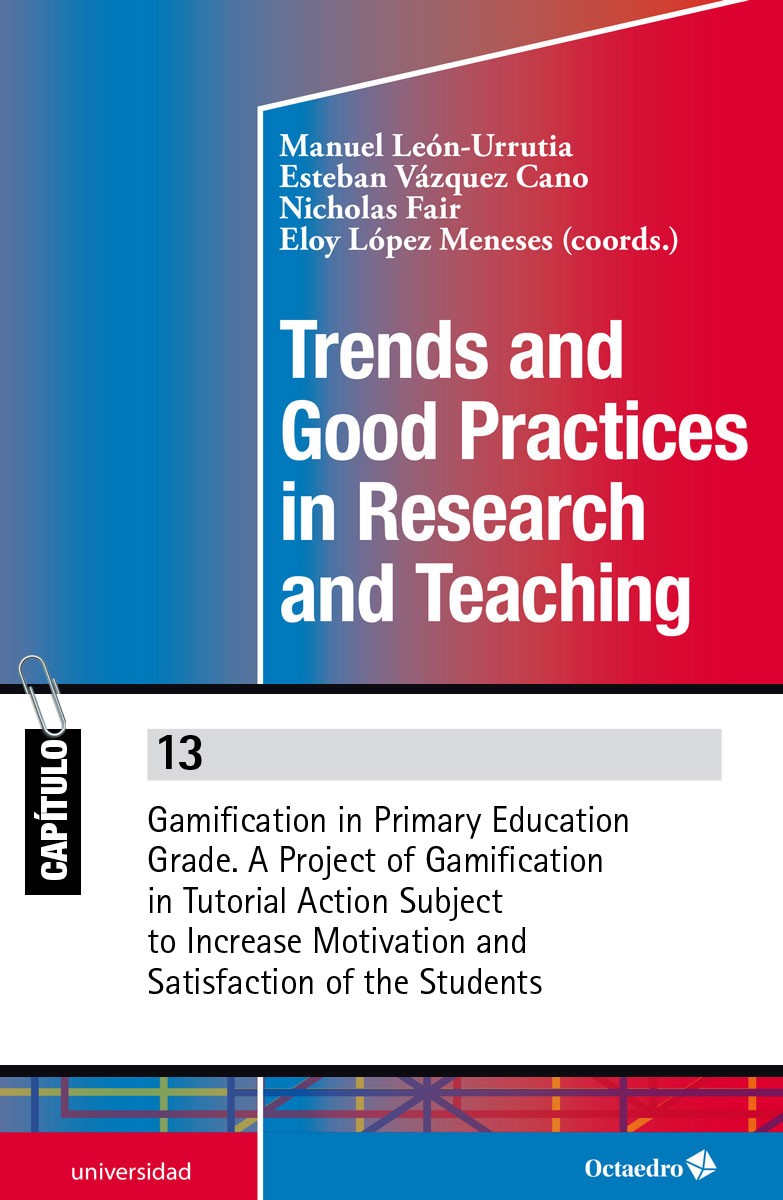FICHA TÉCNICA
Fecha de publicación:
01/01/2020
Doi del capítulo:
Título del libro: Trends and Good Practices in Research and Teaching
URL del libro:
ISBN del libro:
DOI del libro:
Abstract
Nowadays, one of the challenges in education is to maintain students motivated and participating in class. Teachers generally say that students are not involved in class, they do not take part in activities as they are not motivated… One of the new methodologies in education is gamification, which is presented as an active, original methodology, and as an appropriate methodology to get students motivated in their learning process. Gamification is a learning technique that moves the mechanics of games to the educational field. In addition to a theoretical approach, a summary of the activities that have been developed during the course are presented. This chapter presents the experience of a gamified project with students of Primary Education Degree, more specifically in the subject of tutorial action. This project was proposed to try to respond to the need of students of the Primary Education, so that they are motivated and active in the learning of the subject and to foster their participation and satisfaction with their learning. The results have shown an improvement in students’ motivations.
Palabras clave
Autores
Cómo citar
Parra González, M. E., Segura Robles, A., Fuentes Cabrera, A., López Belmonte, J. (2019). Gamification in Primary Education Grade. A Project of Gamification in Tutorial Action Subject to Increase Motivation and Satisfaction of the Students. En León-Urrutia, M., Vázquez Cano, E., Fair, N., López Meneses, E. (coords.) Trends and Good Practices in Research and Teaching. A Spanish-English Collaboration. Barcelona: Octaedro. https://doi.org/10.36006/16184-13
Referencias bibliográficas
- Balducci, F., Grana, C., & Cucchiara, R. (2016). Affective level design for a role-playing videogame evaluated by a brain–computer interface and machine learning methods, The Visual Computer, 33(4), 413-427. doi: 10.1007/s00371-016-1320-2.
- Buckley, P. & Doyle, E. (2014). Gamification and student motivation, Interactive Learning Environments, 24 (6), 1162-1175. doi: 10.1080/10494820.2014.964263.
- Csikszentmihalyi, M. (2002). Flow: The Psychology of Happiness. London: Ebury Publishing.
- De Freitas, S. (2018). Are Games Effective Learning Tools? A Review of Educational Games, Journal of Educational Technology & Society, 21 (2), 74-84.
- Deterding, S., Dixon, D., Khaled, R., & Nacke, L. (2011). From game design elements to gamefulness. In Proceedings of the 15Th International Academic Mindtrek Conference on Envisioning Future Media Environments – Mindtrek ‘11. doi: 10.1145/2181037.2181040.
- Erenli, K. (2013). The impact of gamification: Recommending education scenarios, International Journal of Emerging Technologies in Learning, 8 (SPL.ISSUE), 15-21.
- Expósito, J. (2013). Recursos y materiales para la formación en acción tutorial en educación primaria. Granada: GEU.
- — (2018). Formación teórica y práctica para la acción tutorial en educación primaria. Granada: GEU.
- Goethe, O. (2019). Immersion in Games and Gamification. In Human–Computer Interaction Series. Springer International Publishing, pp. 107-117. doi: 10.1007/978-3-030-11078-9_10.
- Hamari, J. (2017). Do badges increase user activity? A field experiment on the effects of gamification, Computers In Human Behavior, 71, 469-478. doi: 10.1016/j.chb.2015.03.036.
- Hanus, M. & Fox, J. (2015). Assessing the effects of gamification in the classroom: A longitudinal study on intrinsic motivation, social comparison, satisfaction, effort, and academic performance, Computers & Education, 80, 152-161. doi: 10.1016/j.compedu.2014.08.019.
- Hunicke, R., LeBlanc, M., & Zubek, R. (2004, July). MDA: A formal approach to game design and game research. In Proceedings of the AAAI Workshop on Challenges in Game AI, vol. 4, 1, p. 1722.
- Kapp, K. M. (2012). The Gamification of learning and Instruction. San Francisco: John Wiley.
- Lee, J. J. & Hammer, J. (2011) Gamification in education: What, how, why bother?, Academic Exchange Quarterly, 15 (2). 1-5
- Lister, M. (2015). Gamification: The effect on student motivation and performance at the post-secondary level, Issues and Trends in Educational Technology, 3 (2).
- Méndez, R. (2008). Los jóvenes universitarios y su (des)orientación ante los nuevos retos que plantea el EEES, Educatio Siglo XXI, 26, 197-224.
- Méndez, R. & Trillo, F. (2010). El papel de la información universitaria en el proceso de formación de actitudes de los estudiantes hacia la Universidad, Revista de Educación, 353, 329-360.
- Pérez-López, I. & Rivera García, E. (2017). Formar docentes, formar personas: análisis de los aprendizajes logrados por estudiantes universitarios desde una experiencia de gamificación, Signo y Pensamiento, 36 (70), 112-129. <http://dx.doi.org/10.11144/Javeriana.syp36-70.fdfp>.
- Piñeiro-Otero, T. & Costa-Sánchez, C. (2015). ARG (juegos de realidad alternativa). Contribuciones, limitaciones y potencialidades para la docencia universitaria, Comunicar, 44 (22), 141-148.
- Quintero, L., Jiménez, F., & Area, M. (2018). Más allá del libro de texto. La gamificación mediada con TIC como alternativa de innovación en Educación Física, Retos: nuevas tendencias en educación física, deporte y recreación, 34, 343-348.
- Roth, S., Schneckenberg, D., & Tsai, C. (2015). The Ludic Drive as Innovation Driver: Introduction to the Gamification of Innovation, Creativity and Innovation Management, 24 (2), 300-306. doi: 10.1111/caim.12124.
- Reiners, T., & Wood, L. (2015). Gamification in Education and Business. Switzerland: Springer International Publishing.
- Shneiderman, B. (2004) Designing for Fun: How Can We Design User Interfaces to Be More Fun?, Interactions, 11 (5), 48-50
- Zichermann, G. & Cunningham, C. (2011). Gamification by Design: Implementing Game Mechanics in Web and Mobile Apps. Cambridge: O’Reilly Media.
